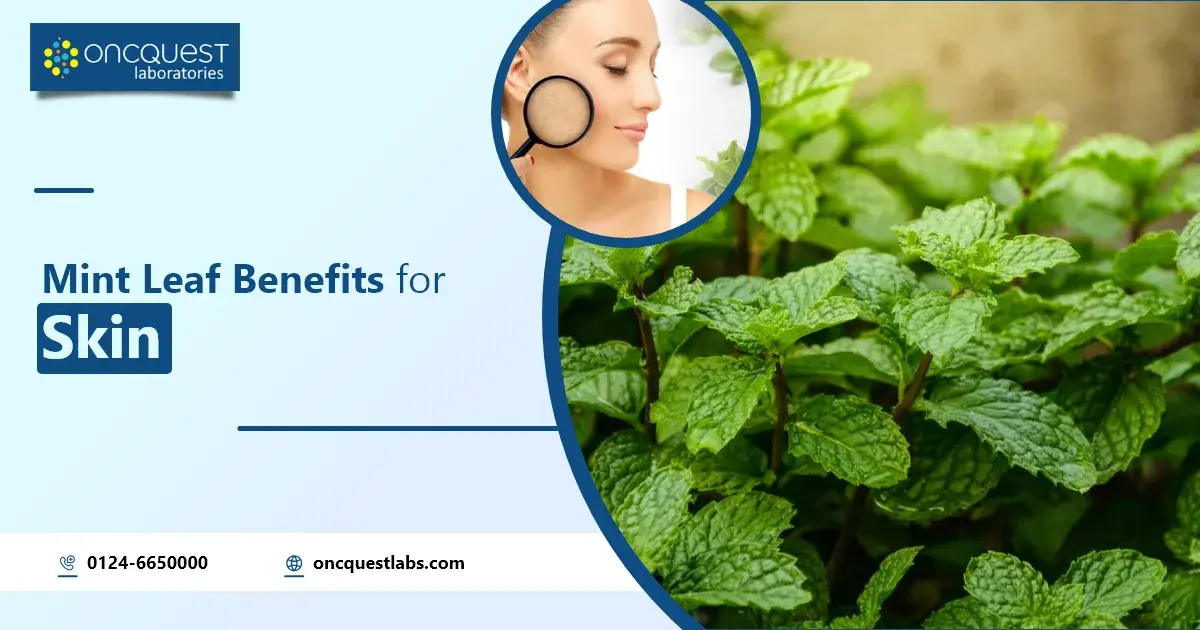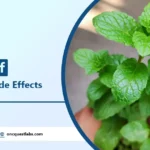Mint leaves, revered for their refreshing flavor and aromatic qualities, have long been celebrated not only in culinary pursuits but also for their profound benefits in skincare. Throughout history, mint has been recognized for its therapeutic properties, particularly in alleviating skin ailments and enhancing complexion. In an era increasingly focused on natural remedies and holistic approaches to skincare, mint leaves stand out for their rich nutritional profile and potent medicinal compounds. This outline explores the diverse array of benefits mint leaves offer for skin health, from their antioxidant and anti-inflammatory properties to their antimicrobial benefits and skin brightening effects. By understanding how mint leaves can rejuvenate and nourish the skin, individuals can harness the power of nature to achieve healthier, more radiant skin naturally.
Contents
Mint Leaves Nutritional Value Per 100g
| Nutrient | Amount per 100g |
| Calories | 70 |
| Protein | 3.75g |
| Fat | 0.94g |
| Carbohydrates | 14.79g |
| Fiber | 8g |
| Vitamin A | 3840 IU |
| Vitamin C | 31.8 mg |
| Vitamin E | 0.82 mg |
| Vitamin K | 200.7 mcg |
| Folate | 144 mcg |
| Calcium | 243 mg |
| Iron | 5.08 mg |
| Magnesium | 80 mg |
| Potassium | 569 mg |
| Phosphorus | 60 mg |
This table provides an overview of the nutritional composition of mint leaves per 100 grams, showcasing their richness in vitamins, minerals, and dietary fiber essential for maintaining skin health and overall well-being.
Mint Leaf Benefits fo Skin
Antioxidant Protection
Mint leaves provide robust antioxidant protection for the skin due to their high content of vitamins C and E, as well as flavonoids. These antioxidants help neutralize free radicals that contribute to skin aging, such as fine lines, wrinkles, and age spots. By combating oxidative stress, mint leaves support skin health by promoting a more youthful appearance and maintaining skin elasticity. Regular use of mint-infused skincare products or homemade treatments can effectively shield the skin from environmental damage while rejuvenating its natural radiance and resilience.
Anti-inflammatory Properties
Mint leaves are prized for their potent anti-inflammatory properties, primarily attributed to menthol and rosmarinic acid. These compounds soothe and calm irritated skin by reducing redness, swelling, and discomfort. This makes mint an effective natural remedy for conditions like acne, eczema, and sunburn. By alleviating inflammation, mint leaves promote skin healing and overall skin health, enhancing comfort and appearance. Whether applied topically or consumed as part of skincare routines, mint leaves offer a gentle yet powerful solution to mitigate skin inflammation and maintain a balanced complexion.
Antimicrobial Action
Mint leaves exhibit strong antimicrobial action, which makes them effective in combating various bacteria, fungi, and viruses on the skin’s surface. This antimicrobial activity is primarily due to the presence of compounds like menthol and thymol. By inhibiting the growth of microorganisms, mint leaves help prevent skin infections and promote overall skin health. This natural antimicrobial property also makes mint an excellent choice for maintaining cleanliness and reducing the risk of acne breakouts and other skin irritations. Regular use of mint-infused skincare products or homemade remedies can support clear, healthy skin by keeping harmful microbes at bay.
Skin Cleansing
Mint leaves are renowned for their effective skin cleansing properties, helping to purify and refresh the skin naturally. The natural oils and menthol in mint leaves act as gentle yet effective cleansers, helping to unclog pores and remove dirt, oil, and impurities from the skin’s surface. This cleansing action not only promotes clearer skin but also helps prevent acne and breakouts by keeping pores free of debris. Mint leaves can be used in various skincare routines, such as homemade facial masks or cleansers, to achieve a deeply cleansed and revitalized complexion without stripping the skin of its natural moisture.
Skin Toning
Mint leaves are excellent natural toners for the skin due to their astringent properties. The menthol in mint helps tighten the skin by constricting the pores, which reduces excess oil and makes the skin appear smoother and more even in texture. This toning effect also helps to firm and refresh the skin, giving it a youthful appearance. Mint leaves can be used as a simple toner by steeping them in hot water, allowing the mixture to cool, and then applying it to the face with a cotton ball. Regular use of mint as a toner can help maintain skin elasticity and improve overall complexion.
Skin Brightening
Mint leaves contribute to skin brightening through their ability to improve blood circulation and promote cell renewal. Rich in antioxidants like vitamin C, mint helps combat oxidative stress and reduce the appearance of dark spots and pigmentation. The cooling sensation of menthol in mint leaves also refreshes and revitalizes the skin, imparting a radiant glow. Regular use of mint-infused skincare products or homemade treatments can effectively brighten the complexion, leaving the skin looking more luminous, even-toned, and rejuvenated.
Moisturizing and Hydrating
Mint leaves provide effective moisturization and hydration for the skin without clogging pores, making them suitable for various skin types, including oily and combination skin. The natural oils present in mint leaves help to lock in moisture and maintain skin’s natural barrier function. Additionally, mint leaves have cooling properties that soothe and refresh the skin, providing relief from dryness and irritation. Whether used in DIY face masks, toners, or moisturizers, mint leaves offer a refreshing and hydrating experience, leaving the skin feeling soft, supple, and revitalized. Regular use promotes balanced hydration and healthy skin appearance.
Healing Properties
Mint leaves possess notable healing properties that can benefit the skin in various ways. The natural antioxidants and anti-inflammatory compounds in mint leaves help to soothe and heal minor cuts, wounds, and insect bites. Their cooling effect provides relief from itching and irritation, promoting faster healing. Mint leaves also have antiseptic properties that can cleanse and protect the skin from infections. Whether applied topically as a poultice or infused in skincare products, mint leaves offer a gentle yet effective solution for promoting skin healing and maintaining overall skin health. Regular use can aid in keeping the skin clear, smooth, and resilient against environmental stressors.
Oil Control
Mint leaves are beneficial for regulating oil production in the skin, making them particularly useful for those with oily or combination skin types. The natural oils and menthol in mint leaves help to balance sebum production, preventing excess oiliness without stripping the skin of its natural moisture. This balancing act helps to keep pores clear and reduces the likelihood of acne breakouts. Mint leaves can be incorporated into skincare routines through homemade masks, toners, or cleansers to maintain a matte appearance and promote a more balanced complexion. Regular use of mint leaves supports healthier-looking skin with minimized oiliness and improved texture.
Refreshing Sensation
Mint leaves provide a refreshing sensation for the skin, thanks to their high menthol content. When applied or used in skincare products, mint leaves impart a cooling and invigorating effect that instantly revitalizes and rejuvenates the skin. This refreshing sensation not only feels pleasant but also helps to soothe and calm irritated skin, making mint leaves a popular choice for skincare routines, especially during hot weather or after prolonged sun exposure. Whether used as a facial mist, infused toner, or in DIY face masks, mint leaves offer a refreshing pick-me-up that leaves the skin feeling cool, refreshed, and energized.
Incorporating mint leaves into skincare routines through DIY masks, toners, or topical applications can harness these benefits effectively, promoting healthier, clearer, and more radiant skin naturally.
How to Use Mint Leaves for Skin Health
- Mint Leaf Face Mask:
- Ingredients: Fresh mint leaves, yogurt, honey.
- Method: Blend a handful of mint leaves with a tablespoon of yogurt and a teaspoon of honey to form a smooth paste. Apply to the face and leave for 15-20 minutes before rinsing with lukewarm water. This mask helps to cleanse, hydrate, and soothe the skin.
- Mint Infused Toner:
- Ingredients: Fresh mint leaves, water.
- Method: Boil a handful of mint leaves in a cup of water for 10 minutes. Allow it to cool, strain, and store the liquid in a spray bottle. Use as a toner by spritzing on the face or applying with a cotton pad to tone and refresh the skin.
- Mint Leaf Scrub:
- Ingredients: Fresh mint leaves, sugar, olive oil.
- Method: Crush a handful of mint leaves and mix with a tablespoon of sugar and a teaspoon of olive oil. Gently massage the scrub onto the face in circular motions to exfoliate dead skin cells and cleanse pores. Rinse with warm water.
- Mint Leaf Steam:
- Ingredients: Fresh mint leaves, hot water.
- Method: Add a handful of mint leaves to a bowl of hot water. Lean over the bowl with a towel draped over your head to trap the steam. Steam your face for 5-10 minutes to open up pores and allow the mint’s properties to cleanse and refresh your skin.
- Mint and Aloe Vera Gel:
- Ingredients: Fresh mint leaves, aloe vera gel.
- Method: Blend a handful of mint leaves with a few tablespoons of aloe vera gel. Apply the mixture to the face as a soothing gel to hydrate, cool, and calm irritated skin.
- Mint Leaf Bath:
- Ingredients: Fresh mint leaves, bathwater.
- Method: Add a generous amount of fresh mint leaves to your bathwater. Soak in the mint-infused water to refresh and rejuvenate your skin, leaving it feeling cool and invigorated.
- Mint Leaf Spot Treatment:
- Ingredients: Fresh mint leaves.
- Method: Crush fresh mint leaves to extract the juice and apply directly to acne spots or irritated areas. Leave it on for 15-20 minutes before rinsing off. This helps to reduce inflammation and clear up acne.
By incorporating these methods into your skincare routine, you can harness the natural benefits of mint leaves to achieve healthier, more vibrant skin.
Conclusion
Mint leaves offer a myriad of benefits for skin health, from their powerful antioxidant and anti-inflammatory properties to their ability to cleanse, tone, and refresh the skin. Whether used in homemade masks, toners, scrubs, or treatments, mint leaves provide a natural and effective way to enhance your skincare routine. Their versatility and potent properties make them a valuable addition to any skincare regimen, promoting clearer, brighter, and more balanced skin. Embracing the natural benefits of mint leaves can lead to healthier, more radiant skin, while also offering a refreshing and invigorating experience.
Frequently Asked Questions (FAQ)
Can I use mint leaves on sensitive skin?
Yes, mint leaves can be used on sensitive skin due to their soothing and anti-inflammatory properties. However, it’s recommended to do a patch test first to ensure there is no adverse reaction.
How often should I use mint leaves in my skincare routine?
Depending on your skin type and needs, you can use mint leaf treatments 2-3 times a week. Overuse might lead to irritation, so it’s important to find a balance that works for your skin.
Can mint leaves help with acne?
Yes, the antimicrobial properties of mint leaves help fight acne-causing bacteria, and their anti-inflammatory properties can reduce redness and swelling associated with acne.
What is the best way to store mint leaves for skincare use?
Fresh mint leaves can be stored in the refrigerator for up to a week. For longer storage, you can dry the leaves and keep them in an airtight container in a cool, dry place.
Are there any side effects of using mint leaves on the skin?
While mint leaves are generally safe, they can cause irritation or allergic reactions in some individuals. It’s important to do a patch test before applying mint leaves to larger areas of the skin.





